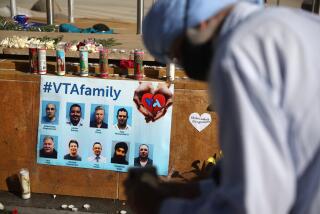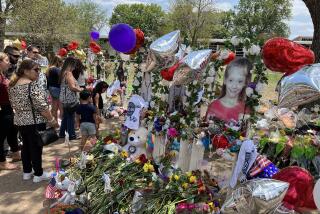Many Warning Signs in Shooting Spree
MERIDIAN, Miss. â Lockheed Martin plant managers knew about Doug Williamsâ volatile temper more than a year before he gunned down 14 fellow employees, killing five, a sheriff investigating the workplace shooting said Wednesday.
âThey were keeping an eye on him.... They were certainly aware of the complaints of employees,â Lauderdale County Sheriff Billy Sollie said.
Williams, 48, a production assemblyman at a Lockheed aircrafts parts factory just outside this industrial city, killed himself with a shotgun Tuesday after the shooting spree. Workers at the plant said he had spoken openly about his hatred of blacks and had threatened to kill his co-workers.
Sollie said that because six of the 14 people killed or wounded were white, âthere was no indication it involved race or gender as far as targets were concerned.â Four of the five people who died were black.
Williamsâ discontent was not limited by race or gender, said Brenda DuBose, an African American who was wounded in Tuesdayâs shooting. âThere were black people he got along with,â she said. âHe was an angry man who was mad about a lot of things.â
On the day of the shooting, Williams -- carrying a shotgun and wearing a bandoleer with ammunition -- entered the room where DuBose cowered on the floor. âDonât worry, Bren,â he told her. âIâm not gonna shoot you.â DuBose was injured by glass shattered by a shotgun blast.
That Williams held onto his job despite employee complaints has some questioning Lockheed management. âHe was a racist, he threatened people and he scared them. Why didnât they fire him?â asked Betty Seals, whose brother Alvin Collier was shot three times but survived.
Lockheed said Wednesday it had acted decisively in the two reported instances of harassment that involved Williams, said spokesman Sam Grizzle. In December 2001, Williams allegedly threatened a black co-worker. Williams acknowledged a problem with his temper and attended two weeks of anger management counseling, Grizzle said.
The second incident, on June 12, involved white cloth booties that some of the assembly workers wore over their shoes. Williams put a bootie on his head. To some, it resembled a Ku Klux Klan hood. âIt was perceived to be offensive, and an employee came to management,â Grizzle said. Williams was told to remove the slipper from his head or go home. He chose to go home and stayed away from work for a week, Grizzle said.
âBoth of these incidents were taken seriously and dealt with promptly,â said Grizzle. âWe can only deal with official complaints that come to the supervisor.â Other than the two complaints, âhis personnel file shows solid job performance over a 20-year period.â
In most states, employers have the right to fire employees for any reason, including concerns about threats or bothersome behavior, said Allan Weitzman, a Boca Raton, Fla., partner in Proskauer Roseâs labor and employment law group. For a variety of reasons, including the investment in the employee, employers often attempt to rehabilitate problem workers first. Some firms, however, take a zero-tolerance approach.
âThere are companies that say, âAnything that looks like it might be of a potentially violent nature, Iâm not giving it a second chance,â â Weitzman said. âAnd they fire that person.â
Lockheed has said it has a zero-tolerance policy for workplace harassment.
There are few tests companies can use to screen prospective employees for violent tendencies, said Dr. John Kennedy, director of the Institute for Psychiatry and Law at the University of Cincinnati and a clinical director of the Center for Threat Assessment, which tests for workersâ propensity for violence.
Instead, he said, companies rely on other employees to bring concerns to managers.
âEven if you canât screen for it, you should be able to identify a good portion of it while itâs happening and then step in to intervene. In this case, his co-workers are saying, âYeah, he would talk about this stuff all the time,â â he said. âThis makes me wonder how much was done.â
Legal experts said that if Williams had been cleared to return to work by anger management counselors, the company would have little legal liability for the deaths and injuries of its workers. They likely would be covered by workersâ compensation funds, which would bar lawsuits against Lockheed for job site deaths and injuries. The law would not bar discrimination suits arising from the shooting, said Richard Simmons, a partner with the Sheppard Mullin law firm in Los Angeles.
If workers can show an employer was aware of racially inappropriate comments and conduct and failed to take steps to correct them, they might have a claim under the federal antidiscrimination statute, he said.
Because Lockheed apparently took steps to address complaints about Williams, lawyers said a case of negligence would be unlikely to prevail, thus limiting the companyâs liability.
*
(BEGIN TEXT OF INFOBOX)
Other workplace shootings
Some recent fatal shootings at U.S. work sites:
Feb. 25, 2003: Emanuel Burl Patterson, 23, allegedly opened fire at Labor Ready Inc., a temporary employment service in Huntsville, Ala., killing four fellow job-seekers and wounding a fifth.
* Feb. 5, 2001: William D. Baker, 66, killed four people, then himself at a Navistar International engine plant in suburban Chicago.
* Dec. 26, 2000: Software tester Michael McDermott killed seven people at a Wakefield, Mass., Internet consulting company, Edgewater Technology Inc. He was convicted and sentenced to life without parole.
* March 20, 2000: Fired employee Robert Harris, 28, shot five people to death at a Dallas-area car wash. He was convicted and sentenced to death.
Source: Associated Press
Los Angeles Times
Hart reported from Meridian, Girion from Los Angeles. Times staff writer Scott Gold contributed to this report.
More to Read
Sign up for Essential California
The most important California stories and recommendations in your inbox every morning.
You may occasionally receive promotional content from the Los Angeles Times.











